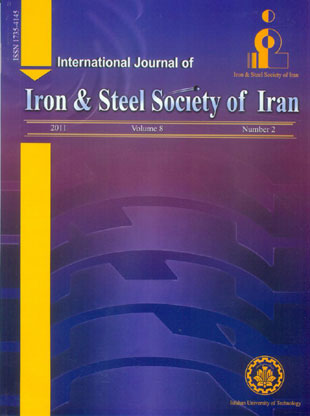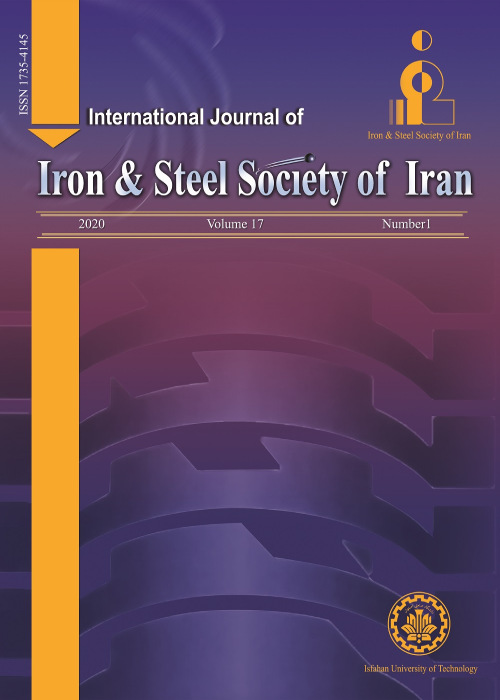فهرست مطالب

International Journal of iron and steel society of Iran
Volume:8 Issue: 2, Summer and Autumn 2011
- 34 صفحه،
- تاریخ انتشار: 1392/03/15
- تعداد عناوین: 7
-
-
Page 1The effects of steel wire patenting process parameters on very fine interlamellar spacing in the pearlitic steel wire were investigated and the optimized condition of the process was achieved. In this work, the initial nanopearlitic structure was obtained in a 0.72 wt% carbon steel wire before the wire drawing process. The results were the minimum interlamellar spacing of 35 nm and maximum ultimate strength of 1960 MPa for austenitizing at 910 ˚C and isothermally transforming to pearlite at 510 ˚C.Keywords: Nanopearlitic structure, High carbon steel wire, Interlamellar spacing, Austenitizing
-
Page 5This research was conducted for the purpose of studying the effect of CaF2 content in the composition of hot metal pretreatment flux, based on lime. It was followed in regards to the importance of fluorine amount decrease in hot metal pretreatment and steel making processes. For this purpose, lime based fluxes including 40, 30, 20 and 10 percent calcium fluoride were prepared and hot metal pretreatment experiments were done in an induction furnace at the temperature range of 1350-1450°C. The obtained results indicated that by using the flux containing 30 percent calcium fluoride, simultaneous removal of phosphorous and sulfurous are in the highest level which is known as a result of slag making with suitable liquid phase volume and adequate basicity. On the other hand, a flux with 20 percent CaF2 caused a small fall in the refining process results. In regards to the harmful effects of fluorine on refractory walls and considering environmental issues, a flux including 20 percent fluorine was introduced as a providing optimum condition. The results have been studied with respect to CaO-CaF2 equilibrium phase diagram, as well as the effect of CaF2 amount on phosphate capacity and lime efficiency of slag.Keywords: CaF2, hot metal pretreatment, lime based flux
-
Page 9Effect of water gas shift reaction (CO+H2O=CO2+H2) on wustite reduction has been investigated by a transient, non-isothermal mathematical model based on grain model. In this model, wustite porous pellet is reduced using Syngas, namely a mixture of hydrogen, carbon monoxide, carbon dioxide and water vapor. For this purpose, governing equations containing continuity equation of species and energy equation have numerically been solved by finite volume fully implicit method. The model has been validated by comparing it with experimental data from literature. It was found a good agreement between model results and experimental data. Model results have been presented for the pellet reduction including with and without Water Gas Shift Reaction (WGSR). It was found that in pellet scale model, the effect of WGSR is not considerable on the rate of wustite reduction and temperature distribution inside the pellet. However it affects the distribution of mole fraction of gaseous species considerably.Keywords: Water Gas Shift Reaction (WGSR), Direct reduction, Wustite pellet, Syngas, Reduction rate, Finite volume method
-
Page 16In recent years, TRIP/TWIP steels have been the focus of great attention thanks due to their excellent tensile strength-ductility combination. The compression tests were performed at different temperatures from 25 to 1000°C to study the mechanical behavior of advanced austenitic steel with 21% manganese plus bearing Ti. The results indicated that the plastic deformation is controlled by deformation-induced martensite and mechanical twinning from 25 to 100°C. However, at temperatures 200 to 1000°C the deformation twinning was merely observed. The occurrence of mechanical twinning at such high temperatures is a first-time observation in high manganese austenitic steels. Such mechanical twins led to grain refinement via grain partitioning.Keywords: Metals, alloys, Phase transformation, Microstructure
-
Page 20Steel 2205 is one of the most famous duplex stainless steels. The microstructure of this steel composed of ferriteand austenite in similar amount. Therefore, in order to improve mechanical properties through microstructure, thermo mechanical processes such as controlled hot rolling and forging should be applied. It is not possible to employ the usual heat treatment. It shows the importance of our knowledge about the steel behavior during hot deformation and the effective mechanisms on the structural change. In the present study, hot compression in two pass process was performed on the 2205 specimens at the constant strain rate of 0.01 S-1and the temperature of 950°C, 1050°Cand 1150°C.The interval time between two pass were selected as, , 50 and 100 seconds and εc≈ 0.7εp was chosen. The results reveal that increasing interval time causes to increase the amount of work softening before the recrystallization leads to decrease in grain size and hardness.Keywords: duplex stainless steel, steel 2205, Two, pass hot deformation, Static recrystallization kinetics
-
Page 24In this research, the activity of MnO, produced during steel making in aluminate-rich slags, was investigated. According to thermodynamic equations and mathematical calculation, a series of relations was obtained for evaluation of oxide activity using Masson’s theory. The obtained relations were solved according to Levenberg- Marquardt method and using Matlab software. The results were correlated with the experimental Data. To derive relations, it was assumed that the solution has ideal behavior and the polymeric chains are linear. Finally, a relation was derived for oxide activity calculation which can be used in a wide range of concentration. MnO activity was investigated at various temperatures, using the experimental data and the obtained relation. Furthermore, the relation between equilibrium constant (K) and temperature was obtained. By means of the results the viscosity of melt can also be forecasted.Keywords: Oxide activity, Masson's theory, MnO
-
Page 27used in copper converter parts. Specimens were cut from an ex-service failed converter part which has been aged for 1900 h. The openings of copper converter in Sarchashmeh Copper Complex in Iran are made of a heat resisting austenitic steel Fe-25Cr-15Ni. Microstructural changes after working period were studied via optical microscopy and scanning electron microscopy equipped with energy dispersive spectrum. The effect of temperature and carbon diffusion on the microstructure, chromium-rich carbides, the chromium carbides transformation to sigma phase and other precipitates during service condition were discussed. The diffusion of SO2 and copper and formation of sub layer decrease the mechanical properties. The formation of sigma phase can be lead to degrade the ductility and toughness.Keywords: Microstructure evolution, Heat resisting steel, Fe, 25Cr, 15Ni alloy, Fracture mechanism, sulphidation


